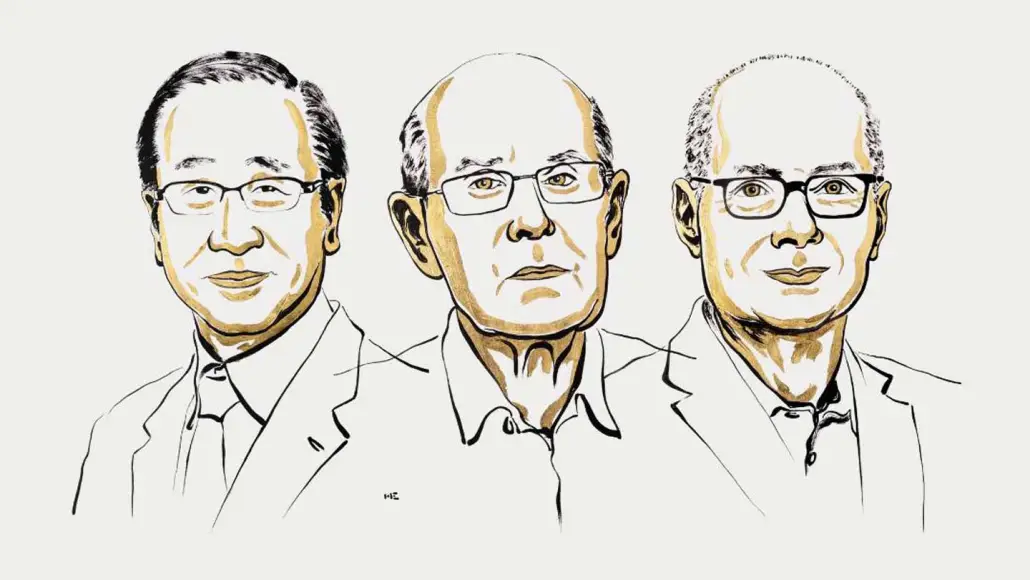In a world battling with escalating climate crises and resource scarcity, the 2025 Nobel Prize in Chemistry shines a spotlight on innovation at the molecular level.
On October 8, 2025, the Royal Swedish Academy of Sciences awarded the prestigious prize to three pioneering chemists: Susumu Kitagawa of Kyoto University in Japan, Richard Robson of the University of Melbourne in Australia, and Omar M. Yaghi of the University of California, Berkeley, in the United States.
Their breakthrough? The development of metal-organic frameworks (MOFs), a disruptive class of porous materials that could transform how we capture carbon, purify water, and store gases.
This isn’t just another conceptual scientific accolade; it’s a concrete win for sustainability. As global temperatures rise and freshwater sources dwindle, MOFs offer practical tools to address these urgent challenges.
Building the Invisible: What Are MOFs?
Imagine constructing a skyscraper out of Lego bricks, but at the atomic scale. That’s the essence of MOFs. These materials are crystalline structures where metal ions act as cornerstones, connected by long organic molecules to form massive, open cavities.
The result? Materials with “unheard of properties,” as described by the Nobel Committee, boasting surface areas so immense that a sugar cube-sized piece could rival the playing field of a football pitch.
The journey began in the late 1980s when Richard Robson pioneered early versions by linking copper ions with multi-armed organic molecules, creating diamond-like crystals filled with pores.
But these initial builds were fragile, collapsing under their own weight. Enter Kitagawa and Yaghi in the 1990s and early 2000s.
Kitagawa demonstrated that MOFs could flexibly absorb and release gases like methane and oxygen without crumbling, while Yaghi engineered ultra-stable versions, like the iconic MOF-5, using rational design to tweak properties for specific needs.
“Metal–organic frameworks have enormous potential, bringing previously unforeseen opportunities for custom-made materials with new functions,” said Heiner Linke, Chair of the Nobel Committee for Chemistry.
A Molecular Arsenal Against Climate Change
What elevates this work from lab curiosity to climate hero? MOFs’ ability to selectively trap and manipulate molecules in ways traditional materials can’t. Here’s how they’re going to redefine sustainability:
Carbon Capture on Steroids:
Cement production, the planet’s third-largest CO₂ emitter (responsible for about 7% of global emissions), is a prime target. MOFs are already deployed at select plants to capture CO₂ before it escapes into the atmosphere, turning a pollutant into a storable resource.
Omar Yaghi emphasised this real-world impact: “I don’t see that as hype; that is an implementation of science, basic science, all the way to benefiting society.”
Water from Thin Air:
In arid regions, MOFs can harvest moisture from desert air, condensing it into drinkable water. Yaghi’s team has commercialised this tech through spin-off companies, proving MOFs can quench thirst where nature falls short.
Taming Toxic Legacy:
Beyond climate, MOFs tackle “forever chemicals” like PFAS, filtering them from contaminated water, and even breaking down pharmaceutical residues in the environment, issues threatening rivers and soils worldwide.
Gas Storage and Beyond:
These frameworks excel at storing hydrogen for clean fuel cells or methane for vehicles, reducing reliance on fossil fuels. They’re also being explored for catalysis, converting captured CO₂ into fuels or chemicals using renewable energy.
Kitagawa envisions even more ambitious applications: “My dream is to capture air and separate air to, for instance, CO₂ or oxygen or water or something and convert this to useful materials using renewable energy.”
The prize money, 11 million Swedish kronor (about $1.2 million), shared equally, dwarfs in comparison to the potential societal payoff.
With companies already commercialising MOFs for energy and purification, we’re witnessing basic research cascade into global solutions.
The Human Element: Journeys of Resilience and Wonder
Behind these molecular marvels are scientists whose lives embody the transformative power of curiosity. Yaghi, born in 1965 to Palestinian refugees in Jordan, grew up in a one-room home shared with family and livestock.
His parents, including his father with a sixth-grade education and his illiterate mother, instilled resilience amid scarcity.
At age 10, a library book on molecular structures ignited his passion: “The deeper you dig, the more beautifully you find things are constructed.” Today, he calls science “the greatest equalising force in the world,” a path from refugee roots to Berkeley professor. “It’s quite a journey and science allows you to do it,” Yaghi reflected.
Kitagawa, 74, a Kyoto native, has long championed “challenge” in research. Honoured yet astonished, he sees MOFs as gateways to turning “invisible gold” the air we breathe, into sustenance.
Robson, 88, the elder statesman born in Britain’s Yorkshire, traded his homeland for Australia in his late 20s.
Their diverse paths including Japanese perseverance, Aussie pragmatism, and Jordanian ingenuity mirror the global stakes of their work.
READ ALSO:
How Tagaddod’s Funding Powers Africa’s Role in Sustainable Aviation Fuel
The Bigger Picture: Chemistry’s Enduring Legacy
This is the third 2025 Nobel announced, after Medicine (on October 7) and Physics (October 8), with Literature up next on Thursday.
Established by dynamite inventor Alfred Nobel in 1895, the prizes have honoured trailblazers from nuclear fission to CRISPR since 1901 (save wartime pauses).
Last year’s Chemistry went to protein structure pioneers David Baker, Demis Hassabis, and John Jumper, fuelling drug discoveries.
Yet chemistry often flies under the radar. This year’s win reminds us: At its core, it’s about reshaping our world, one atom at a time.
As Yaghi advises aspiring chemists, “Just pick anything in your surroundings and think deeply about what it is made of… The deeper you dig, the more beautiful things you find.”
In an era of existential threats, MOFs aren’t just molecules; they’re blueprints for a sustainable future. Could a single framework hold the key? The laureates have built the foundation; now, it’s up to us to scale it.
The Nobel Prize: Honouring Innovation and Peace
The Nobel Prize remains one of the world’s most prestigious honours, awarded annually for exceptional contributions in fields like science, literature, and peace.
Recent discussions have focused on Nobel chemistry and Nobel Prize physics, where groundbreaking discoveries continue to shape modern understanding.
The Nobel Peace Prize, in particular, highlights individuals and organisations promoting harmony and human rights. To better appreciate its legacy, it helps to understand the Nobel meaning, which originates from Alfred Nobel’s vision to reward advancements benefiting humanity.
Each year, the Nobel Prize winners embody that enduring spirit of innovation and peace.
FAQs
Q: Will Trump get a Nobel Prize?
There has been speculation about whether Donald Trump could receive a Nobel Peace Prize due to his role in certain diplomatic agreements, such as the Abraham Accords.
However, as of now, he has not been awarded a Nobel Prize. The decision rests with the Norwegian Nobel Committee, which independently reviews all nominations.
Q: What did Trump say about the Nobel Peace Prize?
Trump on the Nobel Peace Prize has often been vocal. He’s publicly claimed he deserved recognition for his diplomatic achievements and has criticised what he perceives as political bias in the selection process. His comments frequently reignite debate about how peace efforts are evaluated globally.
Ronnie Paul is a seasoned writer and analyst with a prolific portfolio of over 1,000 published articles, specialising in fintech, cryptocurrency, and digital finance at Africa Digest News.

